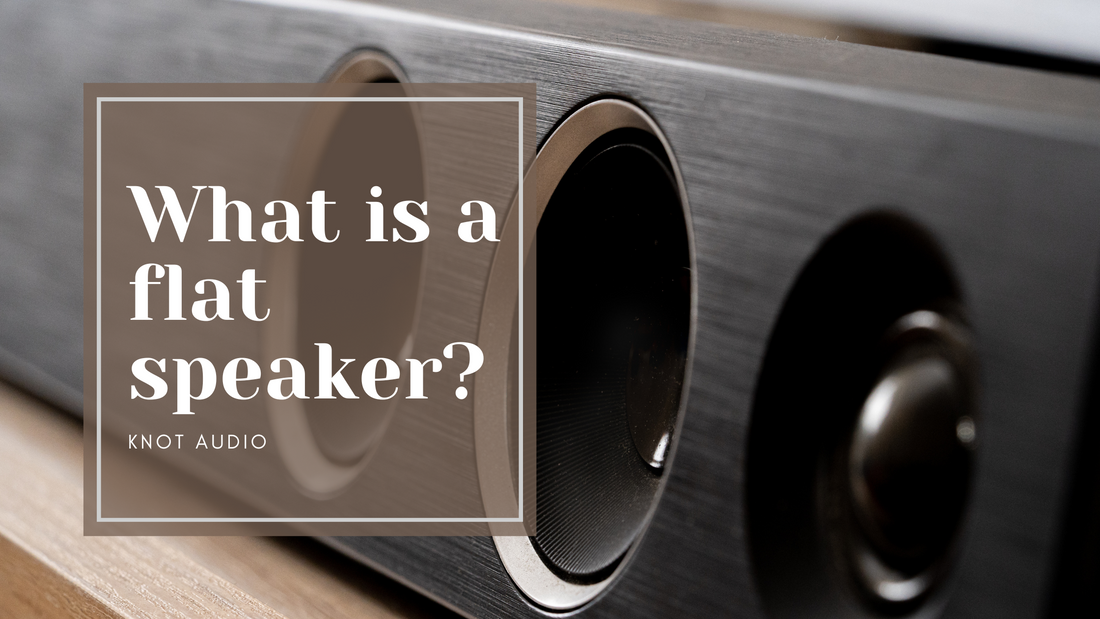
What is a Flat Speaker and How is the Technology Different from Traditional Speakers?
Knot AudioShare
If you are looking for a speaker system that is both accurate and discreet, you might be interested in flat speakers. Flat speakers are speakers that use a thin panel instead of a conventional cone or dome to produce immersive sound just like the body of a guitar of piano. They have a flat design and structure that allows them to be mounted on walls, ceilings, floors, or even furniture without taking up much space or affecting the aesthetics of your room. But how do flat speakers work and what are their advantages and disadvantages compared to traditional speakers? Let's find out.
How Flat Speakers Work
Flat speakers are based on the principle of distributed mode loudspeaker (DML) technology. DML speakers use a small transducer that applies micro vibrations to a resonant panel, such as wood, metal, glass, or plastic. The panel then vibrates in different modes across its surface, creating sound waves that radiate in all directions. Unlike traditional speakers that have a single point source of sound, DML speakers have multiple sources of sound distributed over the panel, hence the name.
The sound quality of flat speakers depends largely on the material and shape of the panel they are mounted on. The panel should be rigid enough to support the vibrations, but flexible enough to allow them to spread evenly. The panel should also have some damping properties to prevent unwanted resonances and distortions. The size and shape of the panel affect the frequency response and dispersion of the sound. Generally, larger and flatter panels produce lower frequencies and wider dispersion than smaller and curved panels.
Advantages of Flat Speakers
Flat speakers have some unique advantages over traditional speakers, such as:
- Space-saving: Flat speakers can be installed on any flat surface without requiring any additional space or stands. They can also be hidden behind paintings, posters, wallpapers, or fabrics for a stealthy look.
- Wide dispersion: Flat speakers produce sound waves that spread in all directions, creating a more immersive and natural sound field. They also reduce the sweet spot effect, meaning that you can enjoy good sound quality from any position in the room.
- Low distortion: Flat speakers have low harmonic distortion and intermodulation distortion, as they do not rely on cones or domes that can flex or break up at high volumes. They also have low power compression, meaning that they do not lose efficiency or dynamic range when driven hard.
- No crossover: Flat speakers are driven by a single set of transducers which use the natural resonance of the attached material to create audio. This prevents the distortion at specific frequencies from being amplified.
- Easy installation: Flat speakers are easy to install and connect, as they do not require any complex wiring or crossover networks. They can be powered by any amplifier or receiver with a suitable output impedance.
Disadvantages of Flat Speakers
Flat speakers also have some drawbacks compared to traditional speakers, such as:
- Limited bass: Traditional flat speakers have difficulty reproducing very low frequencies, as they lack the mass and excursion of conventional drivers. They may require a subwoofer to achieve a full-range sound.
- Panel dependency: Flat speakers depend on the quality and characteristics of the panel they are attached to for their sound performance. A poor panel can ruin the sound quality of a flat speaker by introducing unwanted resonances, reflections, or colorations.
- Cost: Flat speakers tend to be more expensive than traditional speakers of similar quality, as they use more advanced materials and technologies. They may also require more panels to cover a large area or create a surround sound system.
Conclusion
At Knot Audio, we handcraft our flat speakers using local acoustic tone wood and natural finishes to provide the best quality of speakers and bring out its natural beauty. We source locally to support our local lumber and sawmills as we believe in giving back to our community and reducing our environmental impact.
Flat speakers are an innovative and versatile alternative to traditional speakers that offer some unique benefits in terms of space-saving, wide dispersion, low distortion, no crossover, and easy installation. However, they also have some limitations in terms of bass reproduction, panel dependency, and cost. Whether flat speakers are right for you depends on your personal preferences, budget, and listening environment.
